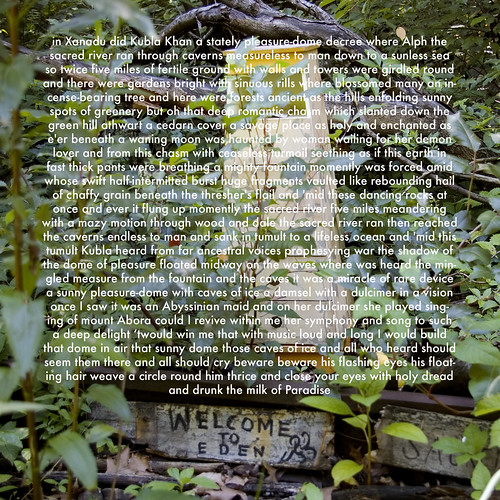In the spring of 1969 I became interested in Coleridge's "Kubla Khan". In the fall of 1970 I began drafting a master's thesis on the poem, hoping to create the kind of theory necessary to make sense out of its underlying logic. The theory didn't happen, but I discovered that the poem had an elaborate structure, one that (extensive) prior criticism had utterly failed to notice. In the fall of 1973 I went off to graduate school, hoping to create the theory I had been unable to create for my master's thesis. While the work I did with David Hays in linguistics was deeply satisfying, it wasn't the theory "Kubla Khan" required.
But that time the poem had become the touchstone of my intellectual life. I returned to it from time to time, thinking about it often and publishing on it in the the late 1980s and then again in the early 2000s. That last article was an advance over the previous one, but still not what the poem required.
I now believe I know what the poem requires and have posted a sketch under the title of this post. Here's the abstract:
Abstract: "Kubla Khan" and "This Lime-Tree Bower My Prison" are constructed on utterly different schemes, though they share some of the same underlying components. "Kubla Khan" is ontological and impersonal in character and makes extensive use of convolution in calculating meanings. It reveals the structure of Being. "Lime-Tree Bower" is narrative and personal and makes little or no use of convolution. It reveals the unfolding of subjectivity in Time. The two poems also differ in their versification, a differences which is related to their different strategies of meaning.
You can download the article here: https://www.academia.edu/35379665/Calculating_meaning_in_Kubla_Khan_a_rough_cut
If you're interested in discussing it, you can do so here: https://www.academia.edu/s/431cfa649a/calculating-meaning-in-kubla-khan-a-rough-cut
When I say, I know what the poem requires, what does that mean? It means that, as far as I can tell, the conceptual space we need for understanding that poem is now "closed". The article outlines the nature of that closure. It will require a book to do significantly better, a book that integrates the ideas in this article with my previous work. The task of actually constructing a deep and satisfying account of the poem within that conceptual space will require the work of investigators having intellectual skills that I lack.

I get side tracked by the Achilles reference.
ReplyDeleteAchilles is the tenor, lion the vehicle, and the ground is some martial virtue "proud heart and fighting fury"
The only calculation Achilles has to make is to survive and win. Nothing else matters.
"at first pays them no attention but goes his way, only when some one of the impetuous young men has hit him with the spear he whirls, jaws open, over his teeth foam breaks out, and in the depth of his chest the powerful heart groans; he lashes his own ribs with his tail and the flanks on both sides"
That line is interesting. It suggests his actions are justified.
Makes me wonder what the Greek legal system may look like in this case for the aftermath of battle?
If I was a 7th century Irish lawyer defending a 'werewolf' that had struck and injured and in turn was injured itself. I would be confident I could win the case. Claim compensation from the person stupid enough to poke it with a spear and maintain the status and freedom of my client (payment here depends on the honor and status of the client, an aggressive legal win establishes that status and reduces the wealth and status of the defendant).
For Achilles and indeed a 7th century Irish lawyer The wider processes gleaned from such actions are not relevant, the knowledge is not required.
The only calculation to be made is to win and to survive